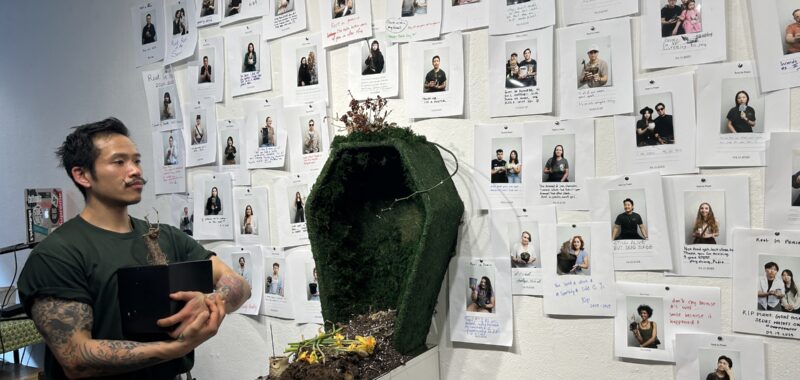What had begun as a vibrant propagation of a monstera vine had withered away into nothing more than a dead leaf and a clump of dried-out roots in a plastic cup of dirt sitting on my bedside table. I’d watched its gradual demise over the course of months while I tried desperately to revive it with water, fertilizer, and in a last-ditch effort, my own voice. But the moment had finally come for me to accept the truth that my lifeless cutting was gone for good. It was time to say goodbye and move on.
With my plastic container of vegetal remains in hand, I entered the Lower East Side gallery Chinatown Soup on late Saturday afternoon, April 19, for my first “plant funeral,” where I was greeted with cheeky signage that read “Welcome Plant Killers!” and the scent of funerary incense mixed with dirt. Inside the narrow arts nonprofit space, I joined a crowd teeming with shriveled leaves, moldy roots, and wilted stems.

Held the weekend before Earth Day, the event was titled “Root in Peace,” and its organizer, Dohyun Lee, told me he aimed to create a communal space for plant owners to process their grief. An art director for the creative ad agency Orchard Creative, Lee said he got inspiration for the event after the death of his own snake plant, a species widely known for being low-maintenance.
“It was under-watered, and then it was over-watered, and the root rot happened,” Lee said. (It reminded me of when I lost my three-year-old aloe plant after a similar chain of mistakes.)
Along a wall to the right, gray tombstones peaked out of black planters arranged next to a photoshopped illustration of flourishing potted plants ascending into heavenly cumulus clouds. To the left, dozens of paper portraits of former plant owners with their empty pots encircled a white pedestal where soil spilled out from an upright mossy open casket.

In the fashion of grave markers, the photos were each captioned with loving apologies and details about the unfortunate fates that had ensnared the lives of plants, now dead and gone like my swiss cheese vine.
“She dreamed of jam, shortcake, and summer salads, but fate (and poor drainage) had other plans,” read one headstone that showed a solemn faced person holding a green pot decorated with a smiley face.
“Root rot of the soul…” read the description below another portrait of a smiling, seemingly relieved couple, proudly holding up a pot with a decayed leaf.
A different photo of a sorrowful couple holding a twig-looking thing simply read “I am sorry” next to an arrow pointing to the culprit, damningly tagged: “She did this.”


I’ll admit, seeing the wall of plant mourners and their beloved casualties made me feel far less alone in my guilt. And as I took my last photo with my plant, I was comforted knowing that its memory would join dozens of others in a mass celebration of their lives.
This solace resonated with other participants in the plant funeral too. Bianca Caniero, who brought a rosemary plant that suffered an abysmal ending when it was left outside on her balcony during the winter. The plant was the first one she had ever lost, and it had left her “completely depressed.”
“ I am looking to just get some closure on this process and maybe by having closure I can grow a rosemary in the future,” Caniero said.
Another participant, Samm Cohen, who brought three dead plants, told me that as an avid gardener, she’s lost many plants over the years and has the habit of holding onto their remains long after they’re gone. The event had motivated her to finally let them go and make space for new life.
“ I thought, ‘Oh, this is a cute idea and I could not feel so guilty because I’m at least giving them a good sendoff and respecting their lives,” Cohen said.

Lee even had a medical professional on-site, Richard Pham, founder of the Brooklyn-based business Plant Daddy MD, to assess each individual case. In the case of my poor propagation, I learned that soil shock was likely what had brought about its end. But I also learned that even professional plant caretakers struggle to keep them thriving.
“ I’ve killed my fair share of plants, I’m not gonna lie,” Pham told me. “ The only way you could truly understand a plant is when you see it through its life, but also its death.”
A nice sentiment, I thought to myself, as he ceremoniously dumped the remains of my plant cutting into a compost bin. On my way out the door, I took a small tombstone consisting of marigold seeds to plant in a new pot that will (hopefully) turn out better.






